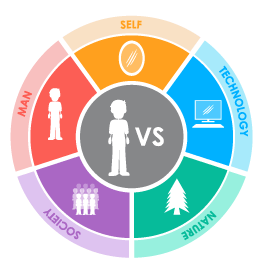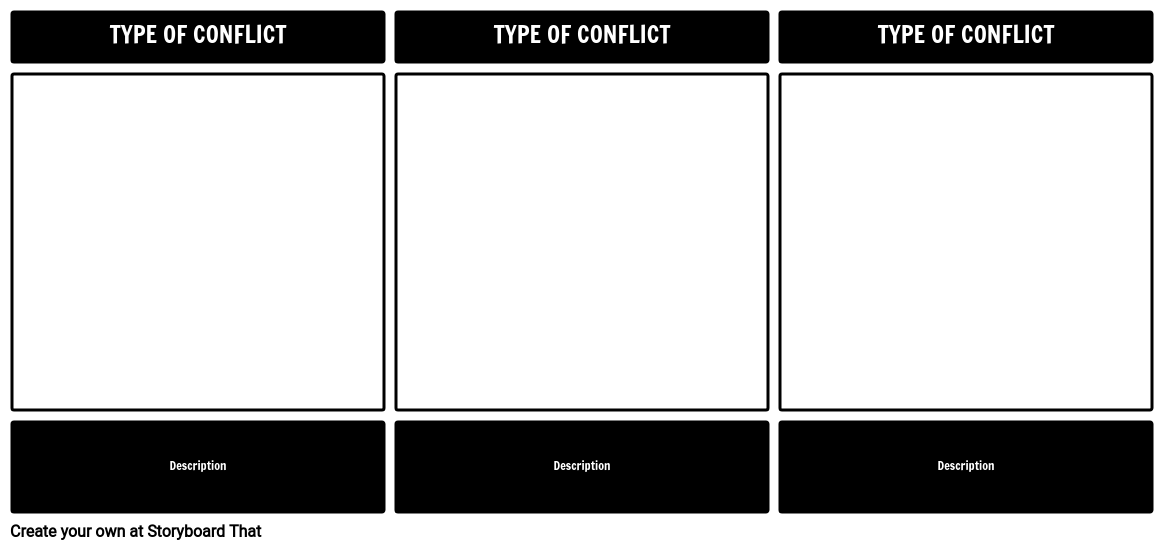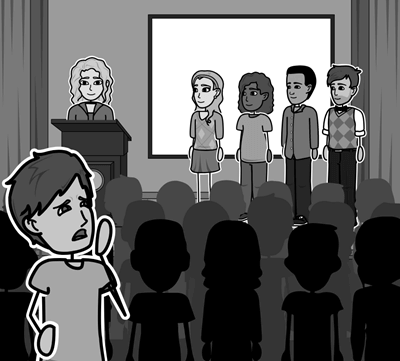Activity Overview
Literary conflicts are often taught during ELA units. Building on prior knowledge to achieve mastery level with our students is important. An excellent way to focus on the various types of literary conflict is through storyboarding. Having students choose an example of each literary conflict and depict it using the storyboard creator is a great way to reinforce your lesson!
In the example storyboard above, each cell contains a particular type of conflict. The type of conflict is displayed, and visually represented with an explanation of the scene, and how it fits the specific category of conflict.
The Giver Conflict Examples
MAN vs. MAN
Jonas vs. The Giver - Jonas is upset with the Giver for not giving everyone the memories to share.
MAN vs. SELF
Jonas vs. Jonas the Receiver - As Jonas grows with his memories and wisdom, he struggles with "release" when he realizes that it actually means death.
MAN vs. SOCIETY
Jonas vs. His Community - Jonas is completely against the community. He leaves to go elsewhere when the infant, Gabe, is threatened with being "released".
Template and Class Instructions
(These instructions are completely customizable. After clicking "Copy Activity", update the instructions on the Edit Tab of the assignment.)
Student Instructions
Create a storyboard that shows at least three forms of literary conflict in The Giver.
- Identify conflicts in The Giver.
- Categorize each conflict as Character vs. Character, Character vs. Self, Character vs. Society, Character vs. Nature, or Character vs. Technology.
- Illustrate conflicts in the cells, using characters from the story.
- Write a short description of the conflict below the cell.
Lesson Plan Reference
- [ELA-Literacy/RL/8/2] Determine a theme or central idea of a text and analyze its development over the course of the text, including its relationship to the characters, setting, and plot; provide an objective summary of the text
- [ELA-Literacy/RL/8/5] Compare and contrast the structure of two or more texts and analyze how the differing structure of each text contributes to its meaning and style
- [ELA-Literacy/W/8/6] Use technology, including the Internet, to produce and publish writing and present the relationships between information and ideas efficiently as well as to interact and collaborate with others.
Rubric
(You can also create your own on Quick Rubric.)
| Proficient | Emerging | Beginning | Try Again | |
|---|---|---|---|---|
| Conflict Identification | Student identifies correct major conflicts and uses strong, clear textual evidence to support choice. | Student identifies correct major conflict and uses few or unclear details to support their choice. | Student identifies incorrect major conflict, and uses some details from the text to support their choice. | Student does not attempt to identify major conflict or identifies incorrect major conflict with no explanation. |
| Understanding Outcome | Student clearly shows the outcome of the conflict and its effects on the protagonist with evidence from the text. | Student shows the outcome of the conflict and its effect on the protagonist, but some evidence is unclear. | Student shows the outcome of the conflict, but does not examine its effect on the protagonist and uses some vague textual evidence. | Student does not clearly show the outcome of the conflict or use textual evidence. |
| Character | Storyboard includes all required characters and clearly names them. Goes above and beyond by adding additional details. | Storyboard includes all required characters and clearly names them. | Storyboard includes protagonist and antagonist but leaves out other required characters. | Storyboard does not include the names of required characters. |
| Storyboard | Student clearly shows effort to convey the setting the scene of the book | Student attempts to convey setting and scene of the book, but lacks some clarity. | Student does not clearly convey the setting and scene. | Student makes little or no attempt to convey the setting or scene. |
| Spelling and Grammar | Student uses exemplary spelling and grammar. There are no errors. | Student makes a minor error in spelling and grammar. | Student makes several minor errors in spelling and grammar. | Student makes many errors in spelling and grammar; little attempt at spellchecking. |
How To Teach Students to Identify Conflict in Novels
Identify the Main Types of Conflict
Create a common vocabulary for students by naming the main types of conflict found in novels. Person vs. Person, Person vs. Self, Person vs. Society, and Person vs. Nature are the main types of conflict found in stories. Define these for your students so they understand what they are looking for.
Practice with Popular Books and Movies
Giving students examples they are already familiar with will help them learn more easily. As a class, discuss conflicts in books or movies that the students already know and love. This will get them thinking about how conflicts are used in a story.
Scaffold for Students Who Need It
Some students will understand these ideas right away, while others will require more help to be able to identify conflicts. Scaffold for students who need it, and challenge others who are doing well.
Use a Storyboard
Students can use a storyboard to describe the major conflict in The Giver. They should use a specific example from the book and create a drawing and write a description to show what they have found.
Frequently Asked Questions about Literary Conflict in The Giver
Why are conflicts so important to a story?
The conflict, in essence, is what moves the story forward. If there was nothing at stake, and nothing to fight for, then the story would be pretty boring. In general, the protagonist needs to solve the conflict in order to get to the resolution of the story.
What is the primary conflict in The Giver?
The primary conflict in The Giver is Person vs. Community because Jonas is fighting against the government and their control over every little thing. He does break free at the end by running away.
More Storyboard That Activities
Giver, The
This Activity is Part of Many Teacher Guides
© 2024 - Clever Prototypes, LLC - All rights reserved.
StoryboardThat is a trademark of Clever Prototypes, LLC, and Registered in U.S. Patent and Trademark Office













